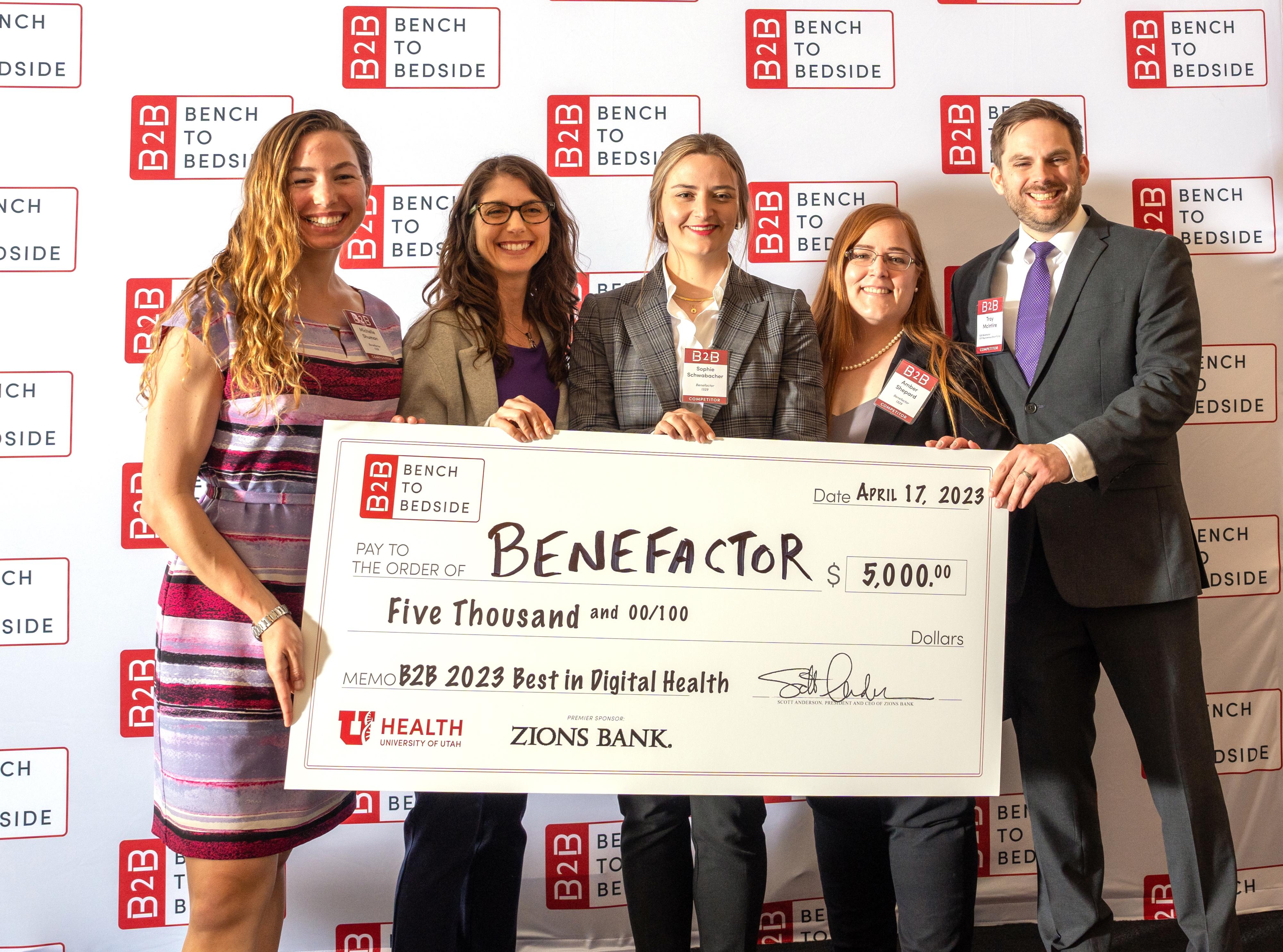The device seeks to improve targeting and placement of catheters into the brain during procedures to treat traumatic head injuries
Twenty-seven student teams showcased next-generation medical device projects at the Utah State Capitol Building on Monday evening. But the grand prize went to SoundPass, which received $20,000 in milestone funding.
Comprised of second- and third-year medical students from the Spencer Fox Eccles School of Medicine at the University of Utah, the SoundPass team focused on improving the highly complex process of placing a catheter into the right lateral ventricle of the brain for patients suffering from traumatic brain injury. Their solution? A device with real-time ultrasound imaging to guide neurosurgeons during the procedure to improve accuracy in placing the catheter. According to the SoundPass team, the device could reduce the number of placement attempts from potentially multiple attempts to a single successful placement.

“Utah’s life sciences industry is among the fastest growing in the nation. Having the Center for Medical Innovation’s Bench to Bedside program available to showcase the talents and skills of students makes it clear the future of health care is bright,” said Mark Paul, Executive Director of the Center for Medical Innovation. “It’s exciting to be around so many bright young people focused on the next generation of health care.”
Hosted by the U’s Center for Medical Innovation, Bench to Bedside annually challenges students to identify and address potential improvements in the current health care market. Interdisciplinary student teams collaborate with practicing health care professionals and industry experts on novel solutions to common problems. This year's winning team worked directly under the mentorship of Dr. Shervin Rahimpour, MD, a neurosurgeon at the University of Utah.
This year, winning teams took home more than $80,000 in milestone funding, receiving awards in categories such as Best in Business, Best in Engineering, Patient Safety, and a Consumer’s Choice Award determined by popular vote at the Competition Night event.
“Utah’s life sciences industry is among the fastest growing in the nation. Having the Center for Medical Innovation’s Bench to Bedside program available to showcase the talents and skills of students makes it clear the future of health care is bright,” said Mark Paul, Executive Director of the Center for Medical Innovation. “It’s exciting to be around so many bright young people focused on the next generation of health care.”
Monday night was Mark Paul’s first official event as executive director, being named to the role earlier this year by University of Utah Health. Paul was introduced by Michael Good, MD, CEO of University of Utah Health, at the beginning of Monday evening’s awards ceremony.
An estimated 350 attendees comprised of students, industry professionals, mentors, investors, entrepreneurs, U leadership, family, and friends filled the Capitol Rotunda. Student teams presented their efforts accumulated over the 2022-2023 school year. This year’s competition boasted more than 80 student competitors representing six different colleges and universities across the state of Utah. In addition, a total of 115 professional mentors and judges also participated.

OcuGuide is an LED-based gaze fixation device that directs the patient’s eye movements and stabilizes fixation during surgery. This noninvasive and risk-free device reduces the need for invasive manipulation of the eye, complex verbal cues, and general anesthesia. By preventing unplanned eye movements during critical parts of eye surgery, the risks and costs of surgical complications are reduced.

LaparoVision from Bloom Surgical empowers robotic laparoscopic surgeons to resolve intraoperative visual disruptions with an in-abdomen, rapid-response scope lens cleaning tool. Our device reduces time spent with compromised vision and scope removals, improving patient safety and procedure efficiency.

A team of healthcare professionals, engineers and an industrial designer spread across Colombia, Venezuela, and the United States created Exocranio. This medical device covers the vulnerable operation site after a decompressive craniectomy while protecting the brain. Comfortable to wear and adaptable to fit a variety of patients and operation sites, Exocranio will improve surgical outcomes and patient care.

VaddiPax is a novel carrying device for left ventricular assist device (LVAD) external components. Our device is an elastic band consisting of several compartments used to store the batteries and controller, that also allows for multiple configurations with varying levels of support.

The ReSense device is designed to help patients rehabilitating after stroke, specifically with hand sensorimotor function. The device aims to retrain the inner cortical map of the hand by providing vibrotactile stimulation at controlled locations. It is intended for use by patients at home or by professionals in rehabilitation facilities. Computer software is used to interface and control the device.

Benefactor is a web-based application that developed in connection with Alaska Legal Services Corporation and the University of Arizona. Benefactor is a portable and flexible technology tool designed to make the first Social Security Disability application as likely to succeed as possible.

The Pegasus Safety Breakaway System elevates the universal utility of common medical tubing by reducing risks to patient safety, hospital liability, and complications inherent in current standard of care.

Nala Diagnostics is working to prevent neonatal Group B streptococcal (GBS) infections through the development of microbiologic screening technology attuned to low-resource settings.

The very first step to effective skincare is protection from harmful ultraviolet radiation overexposure. Through the development of an ultraviolet radiation-detecting wearable sensor that works in parallel with users’ smartphones, individuals will be able to wear the UV Sense device anywhere on their body to stay informed of their sun exposure and understand their limits.
